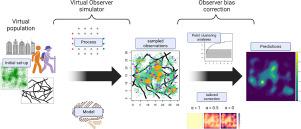Explorers vs. followers: A behavioural approach to spatial bias correction in species distribution modelling
IF 3.2
3区 环境科学与生态学
Q2 ECOLOGY
引用次数: 0
Abstract
In recent years, the increase in data availability through citizen science data collection has raised questions about the quality of this data. Species distribution models can be severely impacted by non-random spatial distributions of records. Multiple methods exist to correct for spatial bias and most of them imply that the sampling is uneven in space and determined by the observers’ choices of where to search for observations. Most methods for addressing sampling biases in opportunistic datasets assume that each observer behaves uniformly, which in practice may not be the case. We focus our study on a widely-used correction method, chosen for its adaptable framework, and assess its effectiveness in mitigating biases from a group of observers with varying behaviours. This method includes a covariate in the model as a bias proxy and corrects for this bias by setting this covariate equal to a constant upon prediction. We differentiate two observer behaviours: exploring and following. Under this paradigm, explorers select destinations far away from the current set of observed points, while followers choose destinations at or near one of the observed points. As such, it is worth investigating whether the current approaches to correcting for observer bias hold under varying observer behaviours, or whether a data-driven approach based on modelled observer behaviour may lead to better predictions. To do so, we developed a new software platform, obsimulator, to simulate patterns of points driven by observer behaviour. We established a correction method based on a bias incorporation approach using k-nearest neighbours. We found that including a bias covariate and setting it to a constant for prediction yields the best results and the strength of the correction differs between cohorts of observers. Additionally, the optimal number of neighbouring points and smoothing parameters depends on the ratio of explorers versus followers in the observers’ cohort.

探索者与追随者:物种分布模型中空间偏差校正的行为方法
近年来,通过公民科学数据收集的数据可用性的增加引起了对这些数据质量的质疑。物种分布模型会受到非随机记录空间分布的严重影响。存在多种方法来纠正空间偏差,其中大多数都意味着采样在空间上是不均匀的,并且取决于观测者在哪里搜索观测值的选择。大多数解决机会数据集中抽样偏差的方法都假设每个观察者的行为是一致的,但在实践中可能并非如此。我们将研究重点放在一种广泛使用的校正方法上,选择其适应性框架,并评估其在减轻一组具有不同行为的观察者的偏见方面的有效性。该方法在模型中包含一个协变量作为偏差代理,并通过在预测时将该协变量设置为常数来校正该偏差。我们区分观察者的两种行为:探索和跟随。在这种模式下,探索者选择远离当前观测点集的目的地,而追随者选择观测点附近的目的地。因此,值得研究的是,当前纠正观察者偏差的方法是否适用于不同的观察者行为,或者基于建模观察者行为的数据驱动方法是否可能导致更好的预测。为此,我们开发了一个新的软件平台obsimulator来模拟由观察者行为驱动的点的模式。我们建立了一种基于k近邻的偏差合并方法的校正方法。我们发现,包括偏倚协变量并将其设置为预测常数可以产生最佳结果,并且在观察者队列之间的校正强度不同。此外,最优邻点数量和平滑参数取决于观察者队列中探索者与追随者的比例。
本文章由计算机程序翻译,如有差异,请以英文原文为准。
求助全文
约1分钟内获得全文
求助全文
来源期刊

Ecological Modelling
环境科学-生态学
CiteScore
5.60
自引率
6.50%
发文量
259
审稿时长
69 days
期刊介绍:
The journal is concerned with the use of mathematical models and systems analysis for the description of ecological processes and for the sustainable management of resources. Human activity and well-being are dependent on and integrated with the functioning of ecosystems and the services they provide. We aim to understand these basic ecosystem functions using mathematical and conceptual modelling, systems analysis, thermodynamics, computer simulations, and ecological theory. This leads to a preference for process-based models embedded in theory with explicit causative agents as opposed to strictly statistical or correlative descriptions. These modelling methods can be applied to a wide spectrum of issues ranging from basic ecology to human ecology to socio-ecological systems. The journal welcomes research articles, short communications, review articles, letters to the editor, book reviews, and other communications. The journal also supports the activities of the [International Society of Ecological Modelling (ISEM)](http://www.isemna.org/).
 求助内容:
求助内容: 应助结果提醒方式:
应助结果提醒方式:


